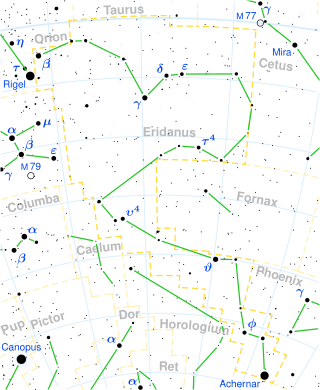Tau4 Eridani (τ4 Eridani, τ4 Eri) is a binary star system in the constellation Eridanus. It is visible to the naked eye with an apparent visual magnitude that varies from 3.57 to 3.72.[2] The distance to this star can be estimated using the parallax method, which yields a value of roughly 300 light years.[1]
 A visual band light curve for Tau4 Eridani, plotted from data published by Tabur et al. (2009)[16]
A visual band light curve for Tau4 Eridani, plotted from data published by Tabur et al. (2009)[16]
Quick facts Apparent magnitude (V), Characteristics ...
τ4 Eridani
Location of τ4 Eridani (circled) |
Observation data
Epoch J2000.0 Equinox J2000.0 (ICRS) |
| Constellation |
Eridanus |
| τ4 Eridani A |
| Right ascension |
03h 19m 31.0006s [1] |
| Declination |
−21° 45′ 28.315″ [1] |
| Apparent magnitude (V) |
3.57−3.72[2] |
| τ4 Eridani B |
| Right ascension |
03h 19m 30.6092s[3] |
| Declination |
−21° 45′ 26.348″[3] |
| Apparent magnitude (V) |
9.5[4] |
| Characteristics |
| τ4 Eridani A |
| Evolutionary stage |
asymptotic giant branch[5] |
| Spectral type |
M3/4 III[6] |
| U−B color index |
+1.79[7] |
| B−V color index |
+1.61[7] |
| Variable type |
Lb[2] |
| Astrometry |
|---|
| τ4 Eridani A |
|---|
| Radial velocity (Rv) | +41.7±0.7[8] km/s |
| Proper motion (μ) | RA: +52.774 mas/yr[1]
Dec.: +32.718 mas/yr[1] |
| Parallax (π) | 10.6153±0.3213 mas[1] |
| Distance | 307 ± 9 ly
(94 ± 3 pc) |
| Absolute magnitude (MV) | −0.79[9] |
| τ4 Eridani B |
|---|
| Proper motion (μ) | RA: +52.919 mas/yr[3]
Dec.: +34.104 mas/yr[3] |
| Parallax (π) | 10.6682±0.1066 mas[3] |
| Distance | 306 ± 3 ly
(93.7 ± 0.9 pc) |
| Position (relative to A) |
|
| Component | B |
| Angular distance | 5.7[4]″ |
| Position angle | 291[4]° |
| Projected separation | 5,800[10] AU |
| Details |
|---|
| τ4 Eridani A |
|---|
| Mass | 1.73±0.3[11] M☉ |
| Radius | 103[12] R☉ |
| Luminosity | 1,537[13] L☉ |
| Surface gravity (log g) | 0.91[14] cgs |
| Temperature | 3,652[12] K |
| τ4 Eridani B |
|---|
| Mass | 0.9[10] M☉ |
| Other designations |
|---|
| τ4 Eridani, τ4 Eri, 16 Eridani, BD−22°584, HD 20720, HIP 15474, HR 1003, SAO 168460[15] |
| Database references |
|---|
| τ4 Eridani A |
|---|
| SIMBAD | data |
|
|---|
| τ4 Eridani B |
|---|
| SIMBAD | data |
Close
The primary components ia an evolved red giant star currently on the asymptotic giant branch[5] with a stellar classification of M3/4 III.[6] It is a slow irregular variable star of type Lb, undergoing changes in magnitude over the range 3.57−3.72[2] with a periodicity of 23.8 d.[16] This star has 1.73 times the mass of the Sun[11] and 103 times the radius of the Sun.[12] It shines with 1,537 times the luminosity of the Sun from its photosphere[13] at an effective temperature of 3,650 K.[12]
The secondary is a magnitude 9.5 star at an angular separation of 5.7″ along a position angle of 291°, as of 2013.[4] This angular separation implies a projected separation of 5,800 astronomical units.[10]


